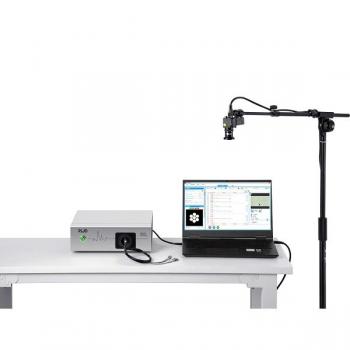R820 Tricolor Multichannel Fiber Photometry System
The RWD R820 three-color multichannel fiber photometric system allows recording calcium and neurotransmitters in neurobiological experiments in different brain areas of awake animals.
- Overview
- Specifications
- Links
A forceful new fiber photometry system can record red and green fluorescence signals, including GCaMP, RCaMP, dLight, and jrGECO1a, while a special 410nm LED is utilized to capture control signals and exclude noise. The system also features an integrated lightweight body and improved software.
The fiber photometry device from RWD may be used to simultaneously record the brain signal from four animals. Moreover, it can be used with an optogenetics system (635nm).
Based on its benefits, fiber photometry calcium imaging is currently a crucial instrument for the real-time detection of brain impulses and is growing in popularity in neuroscience research.
A three excitation light sources for RWD R820 Tri-Color Multichannel Fiber Photometry System are available (410nm, 470nm and 560nm).The system can record the signal from a neurotransmitter probe or a green fluorescence marker like GCaMP and dLight, as well as a red fluorescence marker like RCaMP and jrGECO1a.
Main Applications:
- Detection of Ca2 + and neurotransmitter signals
- Investigate how brain circuits work
- Examine the mechanisms underlying brain disorders.
- Create a novel fluorescent sensor probe
- Investigation on the optical principle
Principle:
Fiber photometry is a technique for identifying neuronal activity in the brain nucleus of animals that are capable of free movement. It summarizes the overall fluorescence of neurons expressing GECIs or neurotransmitter probes, which are genetically encoded calcium indicators.
Since about ten years ago, fiber photometry calcium imaging has been developed and is highly regarded by numerous laboratories. It can be used to investigate the control systems that underlie animal behavior.
Data are gathered in fiber photometry by comparing the fluorescence change (ΔF) to the original baseline fluorescence (F) and tracking the signal change corresponding to the calcium transient (ΔF/F). Fluorophores like GFP, RFP, tdTomato, mCherry, etc., are typically the basis for these measurements; GCaMP is the most prevalent example.
In neurons, calcium ions control the release of neurotransmitters and the excitability of the membrane, among other crucial functions. As GCaMP only fluoresces when attached to calcium ions, fiber photometry calcium imaging can offer vital insight into calcium dynamics. Fiber photometry systems can also identify changes in neurotransmitter levels based on related concepts.
(Neurotransmitter probes - cpEGFP is incorporated into a particular neurotransmitter receptor; upon binding, the receptor undergoes a conformational shift that causes it to transform into a fluorescent signal. This genetically encoded probe is expressed in cells or the mouse brain using viral injection, transfection, and other scientific methods.)
Advantages
Integrates Data Acquisition, Analysis & Plotting
Programming in MATLAB and bonsai software are not necessary. Data clipping, bleaching correction, smoothing, movement correction, event heat map, peak statistics, area under curve, and heat map of behavior trajectory are all part of the data analysis process.
Multiple Behavioral Events Synchronize & Mark
Throughout the trial, the program can synchronize and label a variety of unique behavioral events or external input signals.
More Accurate Signal, Avoid Interference
With the use of two very sensitive dual detectors, fluorescence excitation and detection interference may be avoided, allowing for more precise signal acquisition. The background noise signal can be reflected using the 410nm light source, enabling the collection of actual fluorescence data.
Easy Connection to Other Equipment
With a 4-input and 4-output interface, it is simple to connect to additional devices for the closed-loop research of stimulation and recording, such as optogenetics and electrophysiology.
9 Channels Support
Support up to 9 channels, excellent for experiments involving many animals or different parts of the brain running simultaneously.
You can also visit site of the manufacturer.


